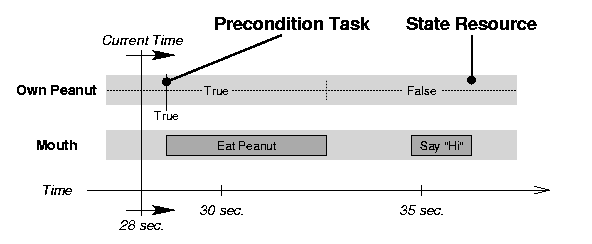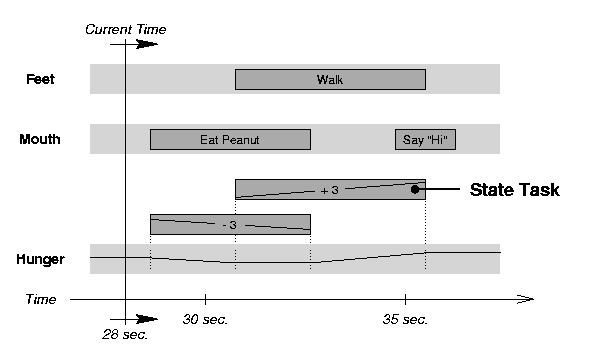
| EXCALIBUR Adaptive Constraint-Based Agents in Artificial Environments |
| [BASICS] | [Actions] [States] [Objects] [Sensors] |
| [ Please note: The project has been discontinued as of May 31, 2005 and is superseded by the projects of the ii Labs. There won't be further updates to these pages. ] |
(Related publications: [PUBLink] [PUBLink] [PUBLink])
A state resource is similar to an action resource. It does not manage actively planned actions, but rather the development of a specific property of the environment or the agent itself. For example, an Own Peanut state resource with a Boolean assignment for any one time can provide information about the possession of a peanut (see figure below).

The status of the state resources can restrict the applicability of actions. To execute the action Eat Peanut, it is first necessary to have a peanut. These relations are checked by precondition tasks of actions. A precondition task includes a state value (or value ranges) that must correspond with the state of a related state resource at a specific time.
The effects of actions are more complicated to realize, as multiple actions and events may have synergistic effects. For example, a state resource Hunger with assignments of natural numbers can be influenced by a beneficial action Eat Peanut and a detrimental Walk at the same time.
It is the job of state tasks to describe an action's effects. For instance, a state task of the action Eat Peanut is responsible for a decreasing contribution of -3 to the state resource Hunger during the action's execution (see figure below). Each state resource has a specific state mapping that maps the contributions of the state tasks to values of the state resource's domain. In the case of the Hunger resource, the synergistic effect is a simple addition of the state tasks' single gradients.

There can be further effects, which may be caused by synergistic effects within a state resource. Adding water to a bathtub may result in its overflowing and wetting the bathroom. The actions cannot provide state tasks to realize these further effects because an action has only the limited view of its state task contributions. Thus, dependency effects of specific state resource states must be expressed in addition. The dependencies are special actions that are beyond the agent's control. Expected external events can also be integrated by these dependencies.
| [BASICS] | [Actions] [States] [Objects] [Sensors] |
For questions, comments or suggestions, please contact us.
Last update:
May 20, 2001 by Alexander Nareyek